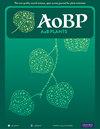Delineation of the impacts of varying BAP (6-benzylaminopurine) concentrations on physiological, biochemical and genetic traits of different olive cultivars under in vitro conditions
IF 2.4
3区 生物学
Q2 ECOLOGY
引用次数: 0
Abstract
The plant growth regulator 6-benzylaminopurine (BAP) is an important component of plant nutrient medium with tendency to accelerate physiological, biochemical and molecular processes in woody plants such as olive. To date, limited knowledge is available on the role of BAP in mediating physiological, biochemical, and genetic activities in olives under in vitro conditions. To cover this research gap, the current study was conducted with the objective of studying the role of BAP in regulating physiological traits (chlorophyll, CO2 assimilation), antioxidant enzymes (superoxide dismutase, catalase, and peroxidase), metabolic contents (starch, sucrose, and flavonoids) and gene expression (OeRbcl, OePOD10, OeSOD10, OeCAT7, OeSS4, OeSuSY7, OeF3GT, and OeChlH) under varying concentrations (0, 0.5, 1.5 and 2.5 mg L-1) within the provided in vitro conditions. The explants obtained from different olive cultivars (‘Leccino’, ‘Gemlik’, ‘Moraiolo’, ‘Arbosana’) were cultured on olive medium (OM) provided with different BAP concentrations using a two-factorial design, and data were analyzed statistically. All traits increased significantly under in vitro conditions due to increasing concentrations of BAP; however, this increase was more dramatic at 2.5 mg L−1 and the least dramatic at 0.5 mg L−1. Moreover correlation, principal component analysis (PCA) and heatmap cluster analysis confirmed significant changes in the paired association and expression of traits with changing BAP concentration and type of olive cultivars. Likewise, the expression of all genes varied due to changes in BAP concentration in all cultivars, corresponding to variation in physiological and biochemical traits. Moreover, the spectrographs generated via scanning electron microscopy further indicated the variations in the distribution of elements in olive leaf samples due to varying BAP concentrations. Although all cultivars showed a significant response to in vitro varying concentrations of BAP, the response of Arbosana was statistically more significant. In conclusion, the current study proved the dynamic impact of the varying BAP concentrations on regulating the physiological, biochemical, and molecular attributes of olive cultivars.体外条件下不同浓度的 BAP(6-苄基氨基嘌呤)对不同橄榄栽培品种的生理、生化和遗传特征的影响分析
植物生长调节剂 6-苄基氨基嘌呤(BAP)是植物营养介质的一种重要成分,具有加速木本植物(如橄榄)的生理、生化和分子过程的作用。迄今为止,关于 BAP 在体外条件下介导橄榄生理、生化和遗传活动的作用的知识还很有限。为了弥补这一研究空白,本研究旨在研究 BAP 在调节生理特性(叶绿素、二氧化碳同化)、抗氧化酶(超氧化物歧化酶、过氧化氢酶和过氧化物酶)方面的作用、过氧化氢酶和过氧化物酶)、代谢含量(淀粉、蔗糖和类黄酮)和基因表达(OeRbcl、OePOD10、OeSOD10、OeCAT7、OeSS4、OeSuSY7、OeF3GT 和 OeChlH)的作用。5、1.5 和 2.5 mg L-1)。采用双因子设计将不同橄榄栽培品种("Leccino"、"Gemlik"、"Moraiolo "和 "Arbosana")的外植体培养在含有不同浓度 BAP 的橄榄培养基(OM)上,并对数据进行统计分析。在离体条件下,随着 BAP 浓度的增加,所有性状都明显增加;但是,在 2.5 mg L-1 浓度下,性状增加更为明显,而在 0.5 mg L-1 浓度下,性状增加幅度最小。此外,相关性、主成分分析(PCA)和热图聚类分析证实,随着 BAP 浓度和橄榄栽培品种类型的变化,性状的配对关联和表达发生了显著变化。同样,在所有栽培品种中,所有基因的表达都因 BAP 浓度的变化而不同,这与生理生化性状的变化相对应。此外,通过扫描电子显微镜生成的光谱图进一步表明,不同浓度的 BAP 会导致橄榄叶片样本中元素的分布发生变化。尽管所有栽培品种对不同浓度的 BAP 都有明显的反应,但 Arbosana 的反应在统计学上更为明显。总之,目前的研究证明了不同浓度的 BAP 对调节橄榄栽培品种的生理、生化和分子属性的动态影响。
本文章由计算机程序翻译,如有差异,请以英文原文为准。
求助全文
约1分钟内获得全文
求助全文
来源期刊

AoB Plants
PLANT SCIENCES-
CiteScore
4.80
自引率
0.00%
发文量
54
审稿时长
20 weeks
期刊介绍:
AoB PLANTS is an open-access, online journal that has been publishing peer-reviewed articles since 2010, with an emphasis on all aspects of environmental and evolutionary plant biology. Published by Oxford University Press, this journal is dedicated to rapid publication of research articles, reviews, commentaries and short communications. The taxonomic scope of the journal spans the full gamut of vascular and non-vascular plants, as well as other taxa that impact these organisms. AoB PLANTS provides a fast-track pathway for publishing high-quality research in an open-access environment, where papers are available online to anyone, anywhere free of charge.
 求助内容:
求助内容: 应助结果提醒方式:
应助结果提醒方式:


